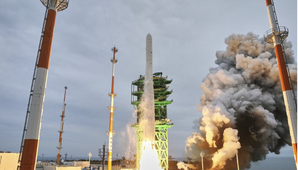Seoul: South Korea’s new national space agency on Thursday said it will work to develop small reusable space rockets in collaboration with the private sector and explore one of the stable Lagrange points in a bid to become a top-five global space power.
In a press briefing, Rho Kyung-won, deputy chief of the Korea AeroSpace Administration (KASA), said KASA plans to assign the reusable rocket development project to the private sector, Yonhap news agency.
These reusable rockets will be capable of launching a 500-kilogram payload into an orbit with an altitude of 500 kilometres, aligning with the latest space trend.
Until now, the South Korean government has led all space projects, focusing on developing single-use space rockets, including the 200-ton rocket Nuri and the next-generation rocket, named KSLV-Ⅲ.
This new plan reflects KASA’s commitment to transforming the country’s space sector from a government-led industry to a private-led one.
KASA also intends to create a launch complex for private space vehicles within the Naro Space Center in the southern coastal village of Goheung, as well as establish a separate space centre at a yet-to-be-determined location.
In addition, KASA plans to unveil a road map to explore deep space beyond the moon and Mars through international cooperation in a bid to expand South Korea’s space economy territory.
Two years ago, the country announced its plan to land a homegrown spacecraft on the moon in 2032 and Mars in 2045.
It now plans to also send a spaceship to L4, one of the five Lagrange points about 380,000 kilometres from Earth, to observe the sun.
Lagrange points are positions in space where the gravitational forces of a two-body system like the sun and Earth create areas of stability, allowing spacecraft to conduct exploration missions with minimal fuel consumption.
Among the five Lagrange points, L4 and L5 are considered stable as they form the apex of two equilateral triangles that have large masses, the sun and Earth, at their vertices.
No country has sent a spacecraft to L4 yet.
KASA also unveiled a plan to train a second Korean astronaut in connection to its push to build a lunar base in the 2040s.
It also plans to develop a strategy to explore the asteroid 99942 Apophis, which is expected to approach Earth in 2029.
KASA’s long-term plans include developing high-resolution and next-generation communications satellites, along with securing deep space optical communications and space internet technologies.
KASA named the envisioned programs the Space Gwanggaeto Project after King Gwanggaeto the Great from the ancient Goguryeo dynasty (37 BC-AD 668), who is known as the greatest conqueror in Korean history.
The agency said it also aims to create a private-led space ecosystem to foster growth and facilitate international cooperation, including taking part in NASA’s “Moon to Mars” programme, which incorporates the Artemis project.
–IANS


Comments are closed.